North Dakota
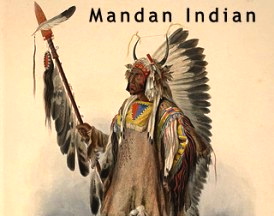
1804-06 Lewis and Clark Expedition Documentary
National Geographic doc. on the 1804-06 Corps of Discovery.
Timeline of North Dakota: 1600’s – 1700’s
- (1610) Henry Hudson claimed Hudson Bay watershed for England, including eastern North Dakota
- (1682) LaSalle claimed Mississippi River drainage, including Missouri River drainage in North Dakota for France
- (1713) France gives England northern North Dakota
- (1738) French explorer, Pierre Gaultier de la Verendyre, visited Mandan villages
- (1762) Land claimed by LaSalle for France given to Spain
- (1794) Rene Jusseaume established fur post near Knife River
- (1797) English explorer, David Thompson, mapped northern part of state
1800’s
- (1801) First white settlement established in Pembina
- (1803) Spain returned Missouri River watershed to France; Louisiana Purchase transferred area from France to United States
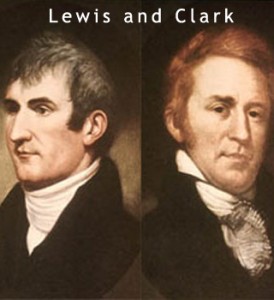 (1804) Lewis and Clark arrived, built Fort Mandan
(1804) Lewis and Clark arrived, built Fort Mandan- (1806) Lewis and Clark expedition arrived at Fort Mandan on return to east
- (1812) William Douglas established a Scottish settlement near Pembina
- (1818) North Dakota became part of Missouri Territory
- (1828) American Fur Company opened Fort Union, remained the most important trading post in the area for 40 years
- (1837) Smallpox epidemic annihilated Mandan Indians
- (1851) Permanent agricultural settlement established at Pembina
 (1860) Regular steamboat service began on Missouri River
(1860) Regular steamboat service began on Missouri River- (1861) Dakota Territory officially organized; William Jayne appointed first governor
- (1863) Dakota Territory opened for homesteading
- (1867) Fort Totten Indian Reservation established
- (1868) Laramie Treaty defined Sioux lands as west of Missouri River in Dakota Territory; Joseph Rolette was first homesteader
- (1870) Fort Berthold Indian Reservation established
- (1874) Col. George A. Custer explored Black Hills, verified existence of gold
- (1875) U. S. War Department allowed white settlement on Indian lands causing major uprising
- (1876) Custer defeated at Little Big Horn River
- (1878) Ranching began in western Dakota Territory
- (1879) Great Dakota land boom began
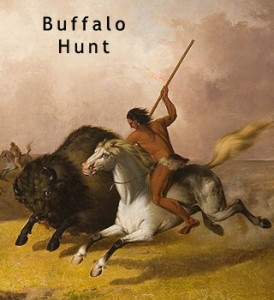 (1882) Last Indian buffalo hunt occurred; fire destroyed much of Grand Forks
(1882) Last Indian buffalo hunt occurred; fire destroyed much of Grand Forks- (1883) Territorial capital moved to Bismarck from Yankton
- (1884) Fire destroyed half of city of Devils Lake
- (1886) Severe winter ended open range ranching
- (1889) North Dakota became 39th state
- (1890) Sitting Bull killed
- (1893) Fire destroyed business section of Fargo
- (1898) Fire destroyed Bismarck business section
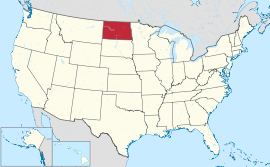 North Dakota (
North Dakota (![]() i/ˌnɔrθ dəˈkoʊtə/) is a state located in the Midwestern region of the United States, along the Canadian border. The state is bordered by Manitoba and Saskatchewan to the north, Minnesota to the east, South Dakota to the south andMontana to the west. North Dakota is the 19th most extensive, but the 3rd least populous and the 4th least densely populated of the 50 United States. North Dakota was created from the northern portion of the Dakota Territory and admitted to the Union on November 2, 1889, simultaneously with South Dakota.
i/ˌnɔrθ dəˈkoʊtə/) is a state located in the Midwestern region of the United States, along the Canadian border. The state is bordered by Manitoba and Saskatchewan to the north, Minnesota to the east, South Dakota to the south andMontana to the west. North Dakota is the 19th most extensive, but the 3rd least populous and the 4th least densely populated of the 50 United States. North Dakota was created from the northern portion of the Dakota Territory and admitted to the Union on November 2, 1889, simultaneously with South Dakota.
The state capital is Bismarck and the largest city is Fargo. The primary public universities are located in Grand Forks and Fargo. The U.S. Air Force operates air bases at Minot AFB and Grand Forks AFB.
For more than a decade, the state has had a strong economy, with unemployment lower than the national average, job and population growth, and low housing vacancies. Much of the growth has been based on development of the Bakken oil shale fields in the western part of the state, but it has also had growth in the technology and service sectors. Flooding in June 2011 has caused extensive damage to Minot and threatened Bismarck, the capital city.
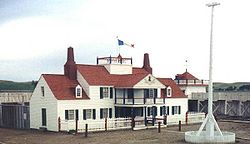 Fort Union Trading Post National Historic Site.
Fort Union Trading Post National Historic Site.
Prior to European contact, Native Americans inhabited North Dakota for thousands of years. The first European to reach the area was the French-Canadian trader La Vérendrye, who led an exploration party to Mandan villages in 1738. The trading arrangement between tribes was such that North Dakota tribes rarely dealt directly with Europeans. However, the native tribes were in sufficient contact that by the time that Lewis and Clark entered North Dakota in 1804, they were aware of the French and then Spanish claims to their territory.
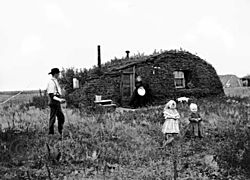 Settlers in front of their sod house in Milton in 1898.
Settlers in front of their sod house in Milton in 1898.
Much of present-day North Dakota was included in the Louisiana Purchase of 1803; the remainder was acquired in the Treaty of 1818. The acquired land was organized into Minnesota and Nebraska Territories. Dakota Territory, making up present-day North and South Dakota, along with parts of present-day Wyoming and Montana, was organized on March 2, 1861.
Dakota Territory was settled sparsely until the late 19th century, when the railroads entered the region and aggressively marketed the land. An omnibus bill for statehood for North Dakota, South Dakota, Montana, and Washington titled the Enabling Act of 1889 was passed on February 22, 1889 during the administration of Grover Cleveland. After Cleveland left office, it was left to his successor, Benjamin Harrison, to sign proclamations formally admitting North and South Dakota to the Union on November 2, 1889.
The rivalry between the two new states presented a dilemma of which was to be admitted first. Harrison directed Secretary of State James G. Blaine to shuffle the papers and obscure from him which he was signing first and the actual order went unrecorded, thus no one knows which of the Dakotas was admitted first. However, since North Dakota alphabetically appears before South Dakota, its proclamation was published first in the Statutes At Large. Since that day, it has become common to list the Dakotas alphabetically and thus North Dakota is usually listed as the 39th state.
Unrest among wheat farmers, especially among Norwegians, led to a radical political movement after World War I centered in the left-wing Non Partisan League (“NPL”). The NPL, which eventually merged into the Democratic Party, attempted to insulate North Dakota from the power of out-of-state banks and corporations. In addition to founding the state-owned Bank of North Dakota and North Dakota Mill and Elevator (both still in existence), the NPL established a state-owned railroad line (later sold to the Soo Line Railroad). Anti-corporate laws were passed that virtually prohibited a corporation or bank from owning title to land zoned as farmland. These laws, still in force today, after having been upheld by both State and Federal courts, make it almost impossible to foreclose on farmland, as even after foreclosure, the property title cannot be held by a bank or mortgage company.
A round of federal construction projects began in the 1950s, including the Garrison Dam and the Minot and Grand Forks Air Forcebases. There was a boom in oil exploration in western North Dakota in the 1980s, as rising petroleum prices made development profitable. The original North Dakota State Capitol burned to the ground on December 28, 1930, and was replaced by a limestone faced art deco skyscraper that still stands today.

